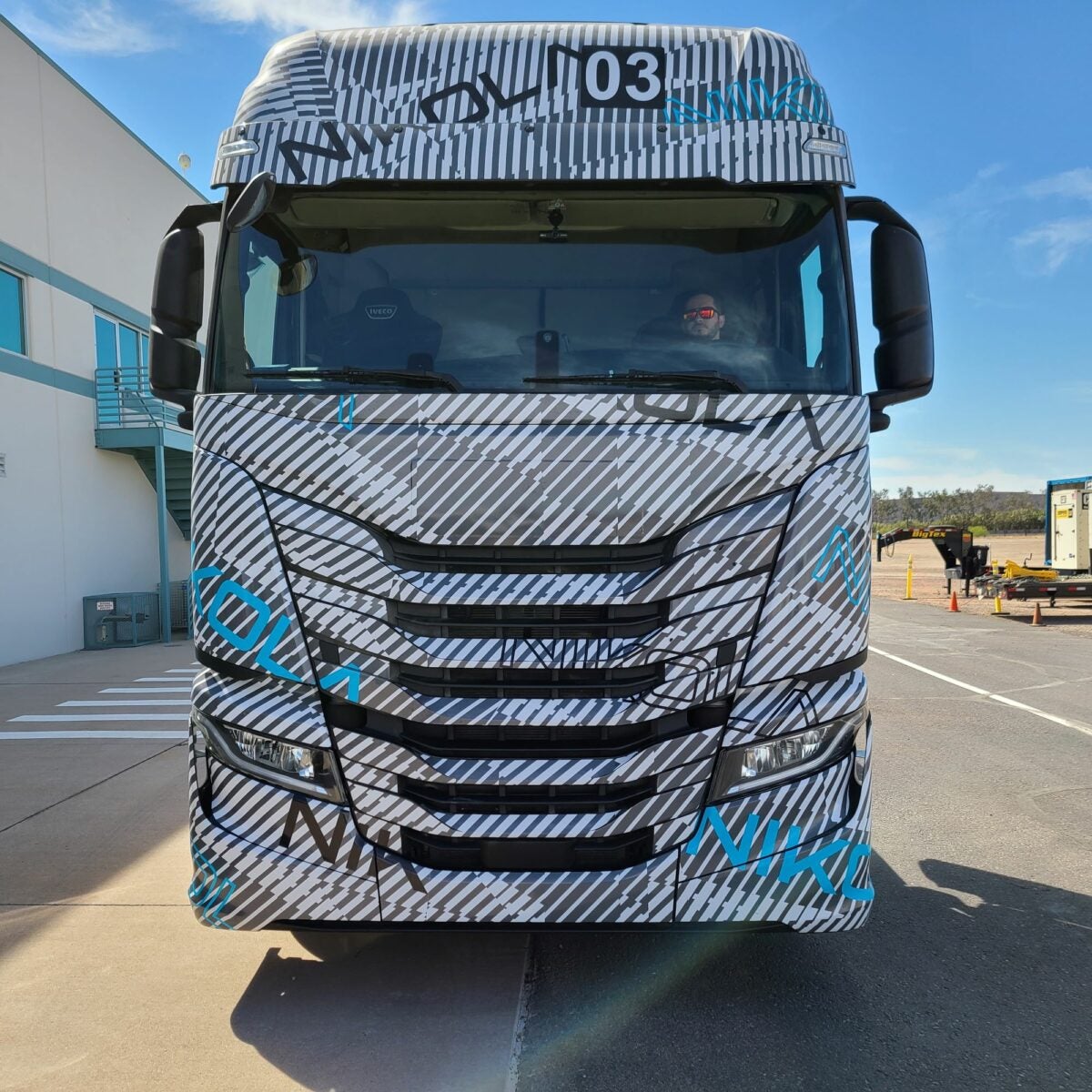Editor’s Note: CORRECTS battery voltage to parallel configuration, deleting reference to 7,200 volts in subhead and substituting 753 kilowatt hours; Clarifies camouflaged trucks are Alpha versions and production intent truck is Beta version.; other clarifications throughout.
PHOENIX — From a minimalist cockpit-style cab with nearly every function visible on a 17 1/2-inch display monitor to whisper-quiet battery-electric operation and a turning radius that could jackknife a typical semi, the Nikola Tre daycab is no enhanced computer image or exaggeration. It is a very real truck.
The proof came during FreightWaves’ exclusive ride last Thursday on a 1.9-mile oval track in the Phoenix area.
Nikola (NASDAQ: NKLA) is racing the clock to deliver after months of harsh media criticism more recently expressed as skepticism. The wheels came off at Nikola last September following a short seller’s report alleging the company was built on a litany of false claims by founder and Executive Chairman Trevor Milton.
The resulting scandal cratered Nikola’s high-flying stock price, prompted Milton’s resignation and scuttled an equity deal with General Motors. Thrust into crisis, Nikola reconstituted its board of directors to restore credibility.
A no-nonsense timeline of production milestones for just two products replaced Milton’s hype about an electric pickup truck, a battery chemistry breakthrough and a powersports division. Those distractions are gone.
Immediate challenges
Nikola, an early pick among dozens of pre-revenue electric vehicle startups backed by special purpose acquisition companies (SPACs), is navigating the same supply chain issues faced by established truck manufacturers with more resources and experience. The Tre comes from a startup, unlike the Freightliner eCascadia and Volvo VNR Electric that are in fleet evaluations.

“We do have headwinds that the rest of the industry, including automotive, is facing,” said Michael Erickson, global head of battery-electric vehicles. ”But we’re working through countermeasures to address those risks and challenges. We’re in validation, and we could be thrown a curveball.”
What Nikola needs most is a steady supply of battery cells, microchips and displays to begin assembly later this month at a new plant in Coolidge, Arizona, where it will assemble trucks from kitted parts imported from Germany along with fully painted cab assemblies from an Iveco plant in Spain.
“There are a lot of challenges ahead of us, especially when we find problems with the short timing that we have,” said Varoujan Sarkissian, global head of vehicle electrical and controls systems. “From the timeline standpoint, we are still on track to deliver in the fourth quarter of 2021.”
Living on the edge
With a rising stock price following a 52-week low in April, Nikola last Friday agreed to sell $300 million in new shares at a 3% discount to entities associated with Tumim Stone Capital over the next three years. It still plans to sell up to $1.5 billion in stock and convertible debt as soon as this summer.
Nikola lives on the fringe of a meme stock rally where short sellers account for just over 32% of available shares. They are betting the stock price will fall but could find themselves squeezed as Nikola progresses toward production and signs deals like one with TravelCenters of America (NASDAQ: TA) to partner on hydrogen fueling stations.
Arizona Power agreed to sell Nikola electricity on the cheap to make hydrogen. In May, Total Transportation Services ordered up to 100 BEV and fuel cell trucks.
Each is a small win that, taken together, adds up to something resembling momentum.
The walk-around
Sarkissian guided a walk-around of a production-intent white Beta version of the truck during an hourlong visit to a facility where Nikola validates the Tre models.
“You can see we have nine square batteries here,” he said. “Every single one of them is the same [800-volt] battery. Basically you can interchange them.”
The battery packs each weigh about 1,100 pounds in parallel configuration. Their combined 753 kilowatt hours of power results in 300 to 350 miles of driving range with up to an 82,000-pound gross weight. The camouflaged Alpha truck in the demonstration run weighed in at 65,000 pounds.
The nine battery packs and the cab together weighted about 29,500 pounds, according to Damon Owens, director of product marketing.
“We just did a survey where we reached out to fleets with a number of different [battery pack] profiles to choose from,” Owens said. “This one did well.”
The redundancy of multiple battery packs provides a backup similar to an airplane that loses function of an engine midflight. Such failures are rare, but knowing it is OK to lose the function of up to three battery packs provides peace of mind.
“This is a brand-new technology. This truck has never been built before. So, there is a lot of calibration work. Every time we refine it, we try to get it to the next level.”
Varoujian Sarkissian, Nikola global of vehicle electrical and controls systems.
A second advantage is modularity. A fleet needing less range can opt for six packs instead of nine. “All we need to do is take and roll it out,” Sarkissian said. “We can even shorten the wheelbase on the truck.”
The power from the batteries gets distributed via two distribution boxes, one in the front and one in the back. The front distribution box is for auxiliary power needs. The rear distribution box is for the traction motors that power the wheels.
Tre’s electronic drive axle has two motors that connect through five chains of gears to the half shaft and link to the tires. Even with the bearings and other moving parts, the powertrain uses a fraction of the 3,000 parts on a conventional internal combustion engine and transmission.
Nikola is pushing its suppliers to make as many 800-volt systems as possible.
“Whenever we can operate at 800 volts, especially at high loads, that’s beneficial for us,” Sarkissian said. “Every time you do a step-down on voltage, you lose efficiency. In our vehicle, our air conditioning compressors, refrigerant compressors, our heaters, all are at 800 volts. Not a lot of people do this.You get a vehicle at this stage and you have multiple voltages.”

The drive
Climbing the steep three steps into the enormous cab of the Beta truck reveals a modern setup with a push-button start and three black switches to move the truck. Copious storage capacity throughout the cab carries over from the S-Way. Two jump seats added to the demonstration truck allow four people in the cab during visits by potential customers.
A lack of engine noise — there is no engine — allows conversations in normal voice. The distance from the cab rearward to the e-axle minimizes operating sound, even tire noise more pronounced on an electric vehicle than ones drowned out by engine noise.
Because the driveline consists of a single speed gear configuration, acceleration from zero to about 50 mph with a trailing flatbed loaded with concrete blocks is smooth and quick. Ditto for reverse, where a touch of a button sent the truck backing with no driver effort.
“It’s a single speed, so you don’t have to change any gears,” Sarkissian said. “The motors start turning forward or backward. You tell them which way you want the torque at.”
Then there is turning. In Europe, where roads tend to be narrower than in the U.S., cabovers are chosen in part because of a tighter turning radius that allows maneuvering in tight spots.
In a turnoff from the oval track, our driver demonstrates how little space is needed to complete a 360-degree turn with the flatbed. Trying this move in a conventional cab could result in a jackknife.
Most of the large screen functionality was offline for calibration during my visit. Seamlessly switching the sound of the horn to mimic an air horn or an electric horn worked fine.
Originally for Europe
The Tre originally was intended exclusively for Europe. But it vaulted the fuel cell electric trucks Nikola plans to build in Coolidge in 2023 because fleets indicated interest and Nikola needs to generate revenue to help fund its fuel cell program.
The camouflaged Tre Alpha vehicles were commissioned in Arizona after arriving from Germany for installation of proprietary software and human-machine interface characteristics that distinguish the Tre from an S-Way.
“This is a brand-new technology,” Sarkissian said. “This truck has never been built before. So, there is a lot of calibration work. Every time we refine it, we try to get it to the next level.”
The first trucks took three months to fully commission. That time dropped to less than a month on the Beta models that arrived more recently.
More than a donor body
Critics point to the Tre as little more than a donor body from Nikola’s partner. That kind of talk exasperates the people who work round the clock on the Tre because on one level, it is true.
“We got a good platform and parts bin when we partnered up with [Iveco]. With the timelines we had, this [allowed] us to focus on electrification,” Sarkissian said. “Most of this is carryover from them. These are not easy things to build.”
So, 85% to 90% of the Tre originated with the S-Way that Iveco introduced in 2019.
“Most of the software on the vehicle is ours,” Sarkissian said. “The functional software, domain software, we write. The vehicle controller module, the thermal module, body controller module, frame controller, the security gateway, the HMI system are all proprietary Nikola developments.”
Nine production-intent Beta versions of the Tre are now in the U.S., bringing the total of Tre units to 14. The cab assembles come from Madrid, Spain. All electric versions of the Tre produced at the Iveco plant in Ulm, Germany, are destined for the U.S. market.
“We do not have an EU truck program of record that we’ve formally kicked off,” Erickson said. “However, we have plans to do that in the relatively near future.”
Related articles:
Going farther: Nikola claims superior Class 8 driving range
TravelCenters of America and Nikola plan California hydrogen stations












Alan
This material is fabulous! It’s full of incisive information and the points you make are rational and solid. Thanks for sharing the details of Nikola electric truck.
For more details, please visit:
http://fazlerasheed.com/
Jeff Wishart
Great article, but you need to fix the unit (and possibly value) in the title. The unit “kilowatt-hour (kWh)” is a unit of energy, not power.
Nick
Every penny should be taken from Milton and returned to shareholders he ripped off!
Eliot
753 kWh would be the combined energy capacity of the batteries. The instantaneous power could be higher than 750 kW.
Did you have a look at the drive axle? Is it indeed of the same design, with the same Meritor independent suspension, as on the Two shown in 2019?
Marcel Mulla
Cabovers are thing of the past nobody likes them. By the way what is the gross weight of the truck? How many miles can you do fully charged and how long it takes to it? What is cost of one and the cost of the battery’s in case of replacement who’s buying the used electric truck after battery dies?
Calvin Chan
The reasons why North Americans didn’t like cabovers are largely not applicable with the Nikola Tre cabover.
1) There is no noisy and hot engine under the cab.
2) There is little need to have to tip the cab over as the engine is not located there.
3) Modern cabovers have suspension that provides ride comfort as good as long nose trucks.
4) There no engine mound inside the cab that the driver needs to climb over.
Incidentally the front of the Nikola Tre opens up providing access to the space under the cab, without having to tilt the cab.
And in terms of advantages, modern cabovers:
1) Are more efficient in fuel usage due to reduced weight.
2) Can carry more load due to reduced weight.
3) Can operate in more confined spaces.
4) Have a smaller turning radius.
About the only remaining advantage I can think of for long nose trucks is they possible are a little more safe if a front end collision occurs.